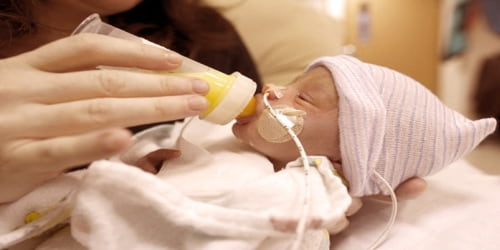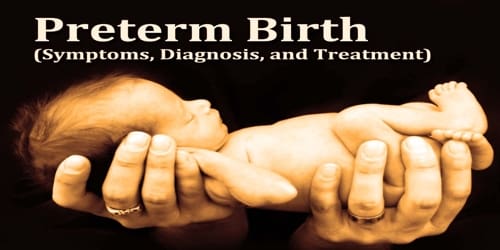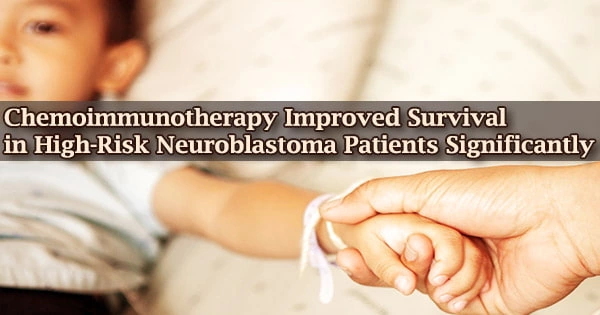Preterm Birth (Symptoms, Diagnosis, and Treatment)
Definition: Preterm birth, also known as premature birth, is when a baby is born too early before 37 weeks of pregnancy have been completed. These babies are known as preemies or premies. Premature babies, especially those born very early, often have complicated medical problems. Typically, complications of prematurity vary. But the earlier people’s baby is born, the higher the risk of complications.
An estimated 15 million babies are born too early every year. That is more than 1 in 10 babies. Approximately 1 million children die each year due to complications of preterm birth (1). Many survivors face a lifetime of disability, including learning disabilities and visual and hearing problems.
Symptoms of preterm labor include uterine contractions which occur more often than every ten minutes or the leaking of fluid from the vagina. Premature infants are at greater risk for cerebral palsy, delays in development, hearing problems and sight problems. These risks are greater the earlier a baby is born.
Globally, prematurity is the leading cause of death in children under the age of 5 years. And in almost all countries with reliable data, preterm birth rates are increasing.
A number of medications, including nifedipine, may delay delivery so that a mother can be moved to where more medical care is available and the corticosteroids have a greater chance to work. Once the baby is born, care includes keeping the baby warm through the skin to skin contact, supporting breastfeeding, treating infections and supporting breathing.
Preterm birth is the most common cause of death among infants worldwide. About 15 million babies are preterm each year (5% to 18% of all deliveries). Approximately 0.5% of births are extremely early periviable births and these account for most of the deaths. The chance of survival at 22 weeks is about 6%, while at 23 weeks it is 26%, 24 weeks 55% and 25 weeks about 72%. The chances of survival without any long-term difficulties are lower.

Signs and Symptoms of Preterm birth: Signs and symptoms of preterm labor include four or more uterine contractions in one hour. In contrast to false labor, true labor is accompanied by cervical dilatation and effacement. Some signs of prematurity include the following:
- Small size, with a disproportionately large head
- Sharper looking, less rounded features than a full-term baby’s features, due to a lack of fat stores
- Fine hair (lanugo) covering much of the body
- Low body temperature, especially immediately after birth in the delivery room, due to a lack of stored body fat
- Labored breathing or respiratory distress
- Lack of reflexes for sucking and swallowing, leading to feeding difficulties
More than 60% of preterm births occur in Africa and South Asia, but preterm birth is truly a global problem. In the lower-income countries, on average, 12% of babies are born too early compared with 9% in higher-income countries. Within countries, poorer families are at higher risk.
If any women deliver a preterm baby, their baby will likely need a longer hospital stay in a special nursery unit at the hospital. Depending on how much care their baby requires, he or she may be admitted to an intermediate care nursery or the neonatal intensive care unit (NICU).

Diagnosis and Treatment of Preterm birth: After people’s premature baby is moved to the NICU, he or she may undergo a number of tests. Some are ongoing, while others may be performed only if the NICU staff suspects a particular complication.
Possible tests for premature baby may include:
- Blood tests
- Breathing and heart rate monitor
- Fluid input and output
- Echocardiogram
- Ultrasound scan
- Eye exam
About 75% of nearly a million deaths due to preterm deliver would survive if provided warmth, breastfeeding, treatments for infection, and breathing support. If a baby has cardiac arrest at birth and is before 23 weeks or less than 400 g attempts at resuscitation are not indicated.
Medications may be given to people’s baby to promote maturing and to stimulate the normal functioning of the lungs, heart, and circulation. Depending on their baby’s condition, medication may include:
- Surfactant, a medication used to treat respiratory distress syndrome
- Fine-mist (aerosolized) or IV medication to strengthen breathing and heart rate
- Antibiotics if an infection is present or if there’s a risk of possible infection
- Medicines that increase urine output (diuretics) to manage excess fluid
- An injection of medication into the eye to stop the growth of new blood vessels that could cause retinopathy of prematurity
- Medicine that helps close the heart defect known as patent ductus arteriosus
After delivery, plastic wraps or warm mattresses are useful to keep the infant warm on their way to the neonatal intensive care unit (NICU). In developed countries, premature infants are usually cared for in a NICU. The physicians who specialize in the care of very sick or premature babies are known as neonatologists. In the NICU, premature babies are kept under radiant warmers or in incubators (also called isolettes), which are bassinets enclosed in plastic with climate control equipment designed to keep them warm and limit their exposure to germs.
Sometimes surgery is necessary to treat a number of conditions associated with prematurity. Talk with your baby’s health care team to understand which complications may require surgery, and learn about the type of surgery that might be necessary to treat them.
The chance of survival at 22 weeks is about 6%, while at 23 weeks it is 26%, 24 weeks 55% and 25 weeks about 72%. The chances of survival without long-term difficulties is less. In the developed world overall survival is about 90% while in low-income countries survival rates are about 10%.
Information Source:
















